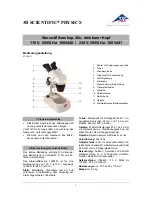
Now rotate the diopter measuring handwheel and at the same time rotate the astigmatism axis
measuring handwheel to focus spherical marking lines clearly once more. Now the reading in the
window is +1.00, which is the same as the first reading. Then rotate the diopter measuring handwheel
to focus the cylindrical marking lines clearly. At this time, the reading on the window is –2.50D,
which is the same as the second reading.
The astigmatism is –3.50D, because (-2.50D)-(+1.00D)= -3.50D. The axis direction is read
directly off of the astigmatism axis measuring handwheel, which is 30º, as shown in Fig. 15 & Fig.
16.
Fig. 15 Image at +1.00D Fig. 16 Image at –2.50D
The final power measured is+1.00 -3.50 x 030º, which can be converted to –2.50 +3.50 x 120º.
Calculation of Prismatic Lens
To measure a prismatic lens below 5
Δ
, place the prismatic lens on the objective lens bearing seat
and aim its optical center at the center of the optical axis. Rotate the diopter measuring
handwheel to focus the lines of the (3) marker reticule clearly. The marking lines can be seen to
deviate from the center of (8) eyepiece reticule. The deviating direction is the base direction of
the prism lens. Rotate the astigmatism axis measuring handwheel so that the middle one of the
three green marking lines passes through the center of the (8) eyepiece reticule. The value of the
base angle of the prismatic lens can be read off according to the astigmatism axis measuring
handwheel. The prism diopters can be estimated according to the reading on the (8) eyepiece
reticule as shown in Fig. 17.
To measure a prismatic lens higher than 5
Δ
, the prism compensation device will be used. Rotate
the diopter measuring handwheel and turn the angle to adjust the division line on (3) marker
reticule to the proper position. Then sum the readings from the (8) eyepiece reticule and the
prism compensation device equals the prism diopter of the lens. The base angle can be read from
the prism compensation device.
9





























